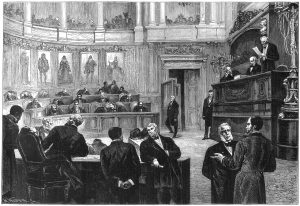Fact check: the 1852 Belgian beer law
 If there’s one thing I’ve learnt from writing about Dutch and Belgian beer during the past few years, it’s that you really need to check anything and that you should never take anything at face value. Of course not everything is easy to verify, but eventually you develop a gut feeling that makes certain claims linger in the back of your head. Claims that make you think: yeah, I need to check those at some point. Which is why today I’ll discuss the 1852 Belgian beer law.
If there’s one thing I’ve learnt from writing about Dutch and Belgian beer during the past few years, it’s that you really need to check anything and that you should never take anything at face value. Of course not everything is easy to verify, but eventually you develop a gut feeling that makes certain claims linger in the back of your head. Claims that make you think: yeah, I need to check those at some point. Which is why today I’ll discuss the 1852 Belgian beer law.
In 1979 Belgian publisher and beer lover Wilfried Patroons wrote a wonderful book called Bier. It’s a rather uncomplicated title for the first book that actually described every single Belgian brewery in detail, at that moment 122 in total. The first book to display Belgian beer culture in all its glory for the general public. And it provides a wonderful snapshot of what Belgian beer was like at that moment.
 However, on page 156, in the section on the Martens brewery in Limburg, we read something quite remarkable: ‘In 1852 there was a new brewery law that set the minimum grain bill at 300 kilograms; as a result of this, six or seven small breweries in Bocholt disappeared; only Martens continued its activities.’[1]
However, on page 156, in the section on the Martens brewery in Limburg, we read something quite remarkable: ‘In 1852 there was a new brewery law that set the minimum grain bill at 300 kilograms; as a result of this, six or seven small breweries in Bocholt disappeared; only Martens continued its activities.’[1]
Hm, interesting. Something similar can be read in a work published somewhat later, the voluminous and well-researched Antwerpen bierstad (‘Antwerp beer city’) from 2011. Here we read that ‘in 1852 parliament voted a new brewery law that stipulated that thenceforth per brew a grain bill of at least 300 kilograms was required. This was the kiss of death for hundreds of home breweries. These were pubs that only brewed for their own consumption or small contract breweries that brewed beer for third parties who supplied the raw materials (grains, hops, spices).’[2]
So I started looking for that 1852 law, that apparently had such far-reaching effects. That shouldn’t be too hard to find, after all a law is not an obscure piece of paper hidden in an attic, but something that always has been public. However, fans of this blog will no doubt guess where this is going: there was nothing, absolutely nothing to be found that even vaguely resembled such a law. The beer law that was in effect in mid-19th century Belgium dated from 1822, when Belgium and Holland had been united as one country, and therefore it has been signed by king William I. That law had been modified and amended somewhat in 1830, 1841, 1844, 1846 and 1851, but there is no trace of a minimum grain bill of 300 kilograms.[3]
Anyway it would have been rather odd had the Belgian government imposed such a restriction, because at the time the tax office was not at all concerned with the amount of grain a brewer used. Excise tax was levied on the size of the mash tun, whether it had been stuffed to the brim with grains or not. Only after the new beer law of 1885 was passed, excise was based on the size of the grain bill, which in practice enabled brewers to make high quality beer instead of extracting as much weak liquid from the mash as possible.[4]
Also, let’s have a look at the number of breweries in Belgium around 1852:[5]
| Year | Number of breweries |
| 1850 | 2894 |
| 1851 | 2875 |
| 1852 | 2886 |
| 1853 | 2850 |
| 1854 | 2785 |
| 1855 | 2705 |
| 1856 | 2692 |
| 1857 | 2671 |
| 1858 | 2690 |
| 1859 | 2730 |
| 1860 | 2736 |
 Was the 1852 beer law (be it real or not) the ‘kiss of death’ for hundreds of small breweries? Not if these figures are anything to go by. We only see a very light downward trend, which already had been going on for a few years.
Was the 1852 beer law (be it real or not) the ‘kiss of death’ for hundreds of small breweries? Not if these figures are anything to go by. We only see a very light downward trend, which already had been going on for a few years.
It wasn’t until the year 1900 that this notorious restriction actually became part of legislation. That year the Belgian beer law was modified, and only then we read: ‘The declaration of adding the grain to the mash tuns or similar vessels can only be made in whole numbers; the total grain bill may not be lower than 300 kilograms.’[6] There you have it: the actual regulation was only passed half a century later than had been claimed. Now of course you ask: did it also result in massive closure of small breweries? Let’s have a look at the numbers:
| Year | Number of breweries |
| 1898 | 3143 |
| 1899 | 3181 |
| 1900 | 3223 |
| 1901 | 3253 |
| 1902 | 3276 |
| 1903 | 3319 |
| 1904 | 3336 |
| 1905 | 3362 |
| 1906 | 3375 |
| 1907 | 3307 |
| 1908 | 3379 |
Nothing could be further from the truth: the number of breweries in Belgium was on the rise and this was not stopped by the new law. In any case, the same 300 kilograms regulation can be found in the 1935 beer law. After the Second World War a new law was passed, basing the excise on original gravity.[7] The minimum size of a brew was set at 100 hectolitre degrees (which means: the number of hectolitres of beer multiplied by the number of degrees Plato).[8]
All in all, the 1852 beer law can henceforth be dismissed as a fairy tale. How does such a story come about anyway? Wilfried Patroons, who wrote down the story in 1979, undoubtedly did so in good faith. He probably heard it from someone at the Martens brewery or maybe he just scribbled down the wrong year. Also, it didn’t spell the end for hundreds of breweries. In any case, it’s just the way myths arise sometimes. In 2005 the 1852 story even found its way to the Dutch-language Wikipedia, again in a way that is hard to reproach: the Wikipedia editor probably copied it from Patroons book or another reference work.[9] Still, once something appears on Wikipedia it really starts to spread: thanks to all the cutting and pasting by other websites the story can now be found all over the worldwide web.
In the end, this myth has been allowed to roam for about forty years. Now it’s time to draw the line: the 1852 beer law never existed.
[1] Wilfried Patroons, Bier, Antwerp 1979, p. 156.
[2] Ivan Derycke (red.), Antwerpen bierstad. Acht eeuwen biercultuur, Brasschaat 2011, p. 80. In fact, author Paul Daeleman is quoting a claim by Jos Cels from his book Streekbieren in Vlaanderen deel 2 from 1995, but I don’t have that particular work in my collection.
[3] W. Frère-Orban, Code des contributions directes, douanes et accises de la Belgique en vigueur au 1er août 1852, Brussels 1852, p. 283-310.
[4] Bulletin de statistique et de législation comparée, jaargang 9 deel 18, Paris 1885, p. 94-104.
[5] Thierry E. Mommens, De Belgische voedingsnijverheid tijdens de 19e eeuw, Leuven 1993.
[6] https://www.dekamer.be/digidoc/DPS/K3018/K30180445/K30180445.PDF. A similar stipulation is already found in a report by the senate from 1887, but I was unable to ascertain that it actually became law before 1900. Cf. https://www.senate.be/lexdocs/S0588/S05881957.pdf.
[7] Cf. La libre Belgique 8-1-1936; De nieuwe gids 30-11-1950.
[8] Gilbert Baetslé, Handboek bij de studie van de mouterij- en brouwerijtechnologie, Gent 1984, p. 281.
[9] https://nl.wikipedia.org/w/index.php?title=Bier&oldid=878965






Leave a Reply